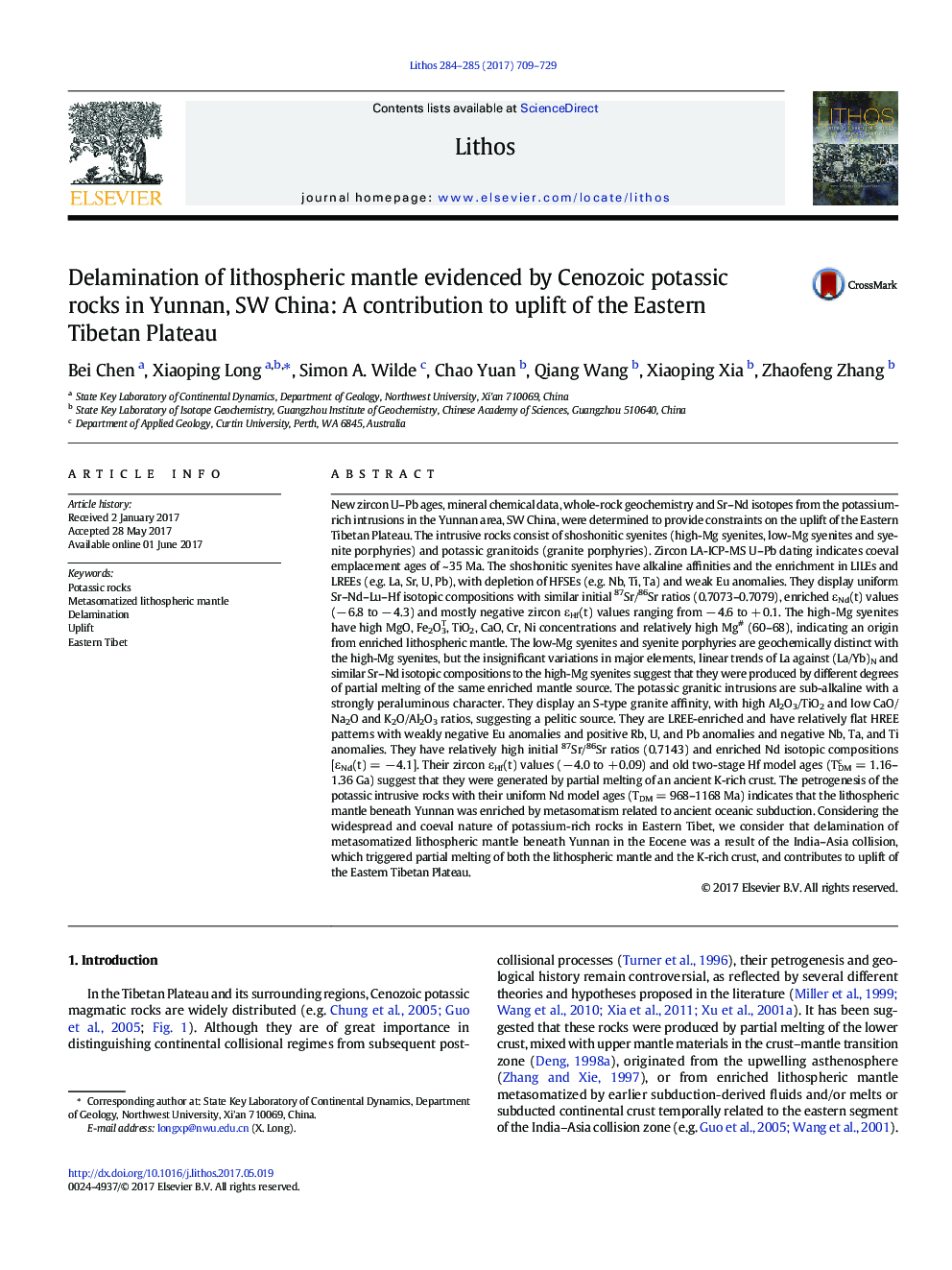| کد مقاله | کد نشریه | سال انتشار | مقاله انگلیسی | نسخه تمام متن |
|---|---|---|---|---|
| 5784067 | 1638630 | 2017 | 21 صفحه PDF | دانلود رایگان |

- Eocene shoshonitic and potassic intrusive rocks exposed in Yunnan formed at ~Â 35Â Ma.
- The shoshonitic intrusions were produced by partial melting of enriched lithospheric mantle.
- The granite porphyries were originated from ancient K-enriched mafic lower crust.
- Formation of these rocks was triggered by delamination of the matasomatized lithospheric mantle.
- The uplift of the Eastern Tibetan Plateau was triggered by delamination of lithospheric mantle.
New zircon U-Pb ages, mineral chemical data, whole-rock geochemistry and Sr-Nd isotopes from the potassium-rich intrusions in the Yunnan area, SW China, were determined to provide constraints on the uplift of the Eastern Tibetan Plateau. The intrusive rocks consist of shoshonitic syenites (high-Mg syenites, low-Mg syenites and syenite porphyries) and potassic granitoids (granite porphyries). Zircon LA-ICP-MS U-Pb dating indicates coeval emplacement ages of ~ 35 Ma. The shoshonitic syenites have alkaline affinities and the enrichment in LILEs and LREEs (e.g. La, Sr, U, Pb), with depletion of HFSEs (e.g. Nb, Ti, Ta) and weak Eu anomalies. They display uniform Sr-Nd-Lu-Hf isotopic compositions with similar initial 87Sr/86Sr ratios (0.7073-0.7079), enriched εNd(t) values (â 6.8 to â 4.3) and mostly negative zircon εHf(t) values ranging from â 4.6 to + 0.1. The high-Mg syenites have high MgO, Fe2O3T, TiO2, CaO, Cr, Ni concentrations and relatively high Mg# (60-68), indicating an origin from enriched lithospheric mantle. The low-Mg syenites and syenite porphyries are geochemically distinct with the high-Mg syenites, but the insignificant variations in major elements, linear trends of La against (La/Yb)N and similar Sr-Nd isotopic compositions to the high-Mg syenites suggest that they were produced by different degrees of partial melting of the same enriched mantle source. The potassic granitic intrusions are sub-alkaline with a strongly peraluminous character. They display an S-type granite affinity, with high Al2O3/TiO2 and low CaO/Na2O and K2O/Al2O3 ratios, suggesting a pelitic source. They are LREE-enriched and have relatively flat HREE patterns with weakly negative Eu anomalies and positive Rb, U, and Pb anomalies and negative Nb, Ta, and Ti anomalies. They have relatively high initial 87Sr/86Sr ratios (0.7143) and enriched Nd isotopic compositions [εNd(t) = â 4.1]. Their zircon εHf(t) values (â 4.0 to + 0.09) and old two-stage Hf model ages (TDMc = 1.16-1.36 Ga) suggest that they were generated by partial melting of an ancient K-rich crust. The petrogenesis of the potassic intrusive rocks with their uniform Nd model ages (TDM = 968-1168 Ma) indicates that the lithospheric mantle beneath Yunnan was enriched by metasomatism related to ancient oceanic subduction. Considering the widespread and coeval nature of potassium-rich rocks in Eastern Tibet, we consider that delamination of metasomatized lithospheric mantle beneath Yunnan in the Eocene was a result of the India-Asia collision, which triggered partial melting of both the lithospheric mantle and the K-rich crust, and contributes to uplift of the Eastern Tibetan Plateau.
Journal: Lithos - Volumes 284â285, July 2017, Pages 709-729